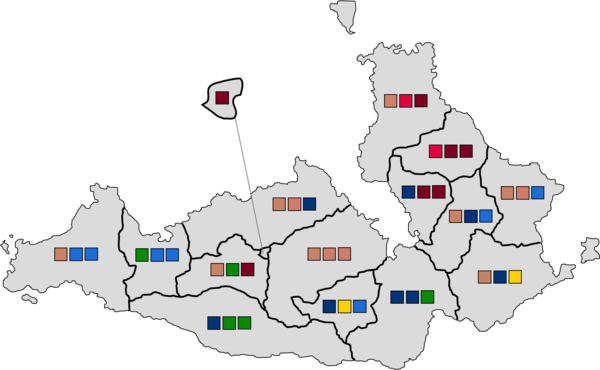Senate (Amrelia)
Senate of the Amrelian Federative Republic | |
|---|---|
| 59th legislature of the Federal Assembly | |
 | |
| Type | |
| Type | |
| History | |
| Founded | August 1, 1780 |
| Leadership | |
President | Amiel Parker, FED since January 22, 2017 |
| Structure | |
| Seats | 43 |
 | |
Political groups | Government (26) |
Length of term | 4 years |
| Salary | ₴93,326/year (USD $105,100) |
| Elections | |
| Plurality voting | |
Last election | December 18, 2020 |
Next election | December 20, 2024 |
| Meeting place | |
 | |
| Senate Chamber, Laurence E. Harvey Building, Federal Square Whiteford, Federal District Amrelian Federative Republic | |
| Constitution | |
| Constitution of Amrelia | |
The Senate of the Amrelian Federative Republic or Senate is the upper house of the Federal Assembly of the Union, and together with the Chamber of Deputies, the lower house, constitutes the bicameral legislature of Amrelia. It is made up of 43 members — each state, regardless of its population size, is equally represented by 3 Senators and the Federal District receives 1 due to its special status. Senators are elected to four year terms by popular vote.
To run for election in the Senate, a candidate must have been an Amrelian citizen for 10 years and be an inhabitant of the state they represent. They must also be at least 40 years old and can no longer serve after reaching the age of 80. There are no term limits, though such an idea has been gaining significant traction for several years.
The Senate has several powers and duties. First, treaties involving Amrelia must first be approved by the Senate. The Senate also approves justices to the Supreme Court, federal judges, ambassadors, and other federal executive officials, to name a few. The Senate may also, along with the Chamber of Deputies, introduce legislation.
When Amrelia became a republic in 1780, the new constitution called for a bicameral parliament. The founders decided that there should be two chambers that would check each other. One chamber would represent the people while the other would equally represent each state and ensure their sovereignty. The Senate has, over time, developed a sense of independence as a "guardian of the institutions" and "guardian of liberties,” favored by the fact that Senators are on average older than members of the Chamber of Deputies and join the house in the last part of their career. Senators are also seen as more "level-headed" than those of the Chamber, partly thanks to its smaller size and statewide constituencies, which historically led to a more collegial and less partisan atmosphere.
History
dd
Current composition
Composition of the 59th Senate (2020-2024)| Parties | Main Ideology | Members | ||
|---|---|---|---|---|
| FED | Federalist Party | Christian democracy | 12 | |
| REP | Republican Party | Liberal conservatism | 7 | |
| LIB | Liberal Party | Social liberalism | 7 | |
| NF | National Front | National conservatism | 8 | |
| GRN | Green Party | Green politics | 5 | |
| APP | Amrelian People's Party | Conservatism / Economic liberalism | 2 | |
| SDP | Social Democratic Party | Social democracy | 2 | |
Powers and function
In terms of legislation the Senate, like the Chamber of Deputies, may introduce legislation. The approval of both houses is required for a bill to become law. Both houses must pass the same version of the bill; if there are any differences they may be resolved by sending amendments back and forth or by establishing a special committee for the purposes of that bill which includes members of both houses.
While both houses of the Federal Assembly have similar powers, the Senate is provided with several unique functions by the Constitution for the purposes of checking and balancing the powers of other elements of the government. It performs advise and consent duties to the Federal Directory's appointments, tries all impeachments and approves treaties with foreign governments. The Senate also monitors the current administration's actions by publishing many reports each year on various topics.
Criticism
ff
